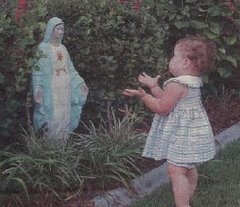 When new palms are distributed at Palm Sunday Mass, I let mine dry in a flat position before placing them above a picture of Jesus or above a mirror associated with a small shelf used as an altar for veneration of sacred objects. Depending on the month, either a statue of the Blessed Virgin Mary or a statue of the Sacred Heart of Jesus is placed on the shelf. On May 1, my husband will replace our Sacred Heart statue with one of Mary, the Mother of God. In June, he'll do the reverse.
When new palms are distributed at Palm Sunday Mass, I let mine dry in a flat position before placing them above a picture of Jesus or above a mirror associated with a small shelf used as an altar for veneration of sacred objects. Depending on the month, either a statue of the Blessed Virgin Mary or a statue of the Sacred Heart of Jesus is placed on the shelf. On May 1, my husband will replace our Sacred Heart statue with one of Mary, the Mother of God. In June, he'll do the reverse.The old palms are taken down and burned but it is sometimes hard for them to catch a good fire. This year I decided to use a small "stainless" steel pot to burn the old palms and then distribute the ashes around our house or garden, asking God for protection from lightning, hail, and other bad weather events. BAD mistake! (That is, to use the stainless steel pot.) But I learned several good lessons from trying to clean the hard black carbon that stuck like glue to the inside of the pot.
First, the natural effect of sin is very difficult to remove, like the carbon that took about 15 minutes of scrubbing with a nylon pad and powder cleanser to get the pot clean again. Second, if I had been smart, I would have found it easier to spray the inside of the pot with oven cleaner and leave it within a black plastic bag in the sun (compare to prayers with indulgences). After a while, the black would have been easy to scrub off. Lastly, next time I'll use a clean disposable can for burning old palms!






















